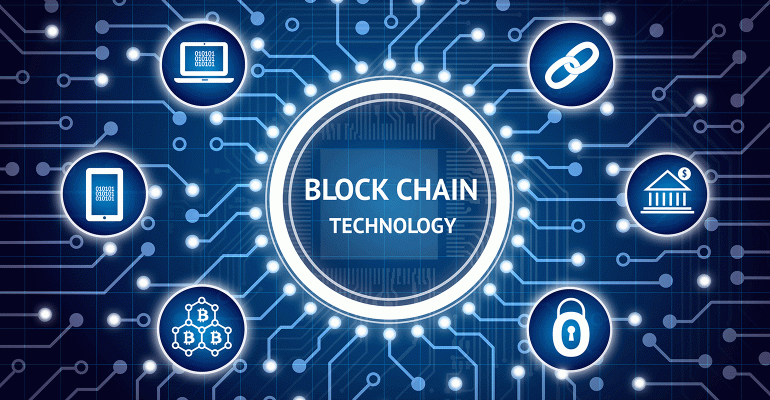Blockchain and Global Trade
June 1, 2018 | Expert Insights

The spectre of protectionism, geopolitical competition, and risk of tariff wars have recently made the underpinnings of global commerce seem insecure.
Blockchain, a so-called distributed-ledger technology, allows transactions to be validated without the use of a centralized database.
Background
Blockchain is the world's leading software platform for digital assets. It is a decentralized and distributed digital ledger of cryptocurrency. It cannot be controlled by any single entity and it has no single point of failure. Don & Alex Tapscott, authors of the book Blockchain Revolution have noted blockchains cannot be corrupted. They wrote, “The blockchain is an incorruptible digital ledger of economic transactions that can be programmed to record not just financial transactions but virtually everything of value.”
According to IBM’s official website, blockchain can be described as, “a shared immutable ledger for recording the history of transactions. A business blockchain, such as IBM Blockchain and the Linux Foundation’s Hyperledger Project, provides a permissioned network with known identities. And unlike Bitcoin, there is no need for cryptocurrency exchange.”
Blockchains are secure by design and are an example of a distributed computing system with high Byzantine fault tolerance. Decentralized consensus has therefore been achieved with a blockchain. The first blockchain was conceptualized in 2008 and was created by someone going by a possible pseudonym called Satoshi Nakamoto. Called the Bitcoin, it was implemented in 2009.
Analysis
Blockchain technologies is poised to dramatically reshape the world of manufacturing and, in the process, render obsolete the existing international trade regime. This is particularly true in the case of 3D printing, the application of internet-of-things (IoT) devices to shipping and logistics, the increasing prevalence of artificial intelligence and machine learning.
It has the intrinsic capacity to help non-trusting parties to transact with each other by relying on a common source of digital truth, thereby acquiring the potential to become the new gold standard of business and trade.
The global refugee situation and terrorist threats have led to tighter border controls – and these increase transaction costs. Every inspection of goods, every stop along the supply chain, eats up time and drives up prices. It harms businesses and consumers alike.
The first blockchain-based, trade-finance deal was reported by Barclays in September 2016. The transaction guaranteed the trade of almost $100,000 worth of cheese and butter between Irish agricultural food co-operative Ornua and the Seychelles Trading Company. The process – from issuing to approval of the letter of credit, which usually takes between seven and 10 days – was reduced to less than four hours.
There are two important barriers to the widespread adoption of a global blockchain-based trade architecture. The first concerns the desire for legal certainty, and independent verifiability, of unique blockchain identifiers, which are currently often represented as QR (Quick Response) codes. The second relates to the liability and validity of data written to an immutable blockchain, specifically what to do in the case of erroneous or fake data.
The history of the Internet's development offers a useful framework for addressing the question of legal verifiability. Verifying a blockchain address is conceptually similar to resolving cross-border accountability issues with Internet Domain Names. It identifies the need for a Blockchain Naming Service (BNS), with common business identity standards to interface with sovereign company registries.
The formation of the Global Smart Container Alliance last year was a defining moment to drive standards both for smart shipping containers that record and report the ambient state of their cargo and for "E-locks," which are used to electronically seal the container for faster customs and duty clearance.
A highly disruptive outcome of blockchain integration into global manufacturing and trade is the prospect that businesses will move from "push" supply chains to "pull" demand chains. The idea is that that production will be configured in response to – or pulled by – customer demand rather than pre-configured on anticipation of what customers want and then pushed onto them.
Blockchain’s role is to help market participants break up long value chains into shorter ones, with financial exchanges acting as bridges between them. This should result in greater liquidity and enhanced price and market discovery.
Imagine a footwear maker gets a Request for Quotation (RFQ) for a batch of customized shoes for Argentina`s national soccer team that must be rushed in time for next month's World Cup. The shoes might be "Designed In Germany" – the home of the intellectual property – but "Made in Argentina" by a trustworthy 3D printer somewhere in Buenos Aires to produce the product and fulfil this order.
Demand chains are particularly useful when accurate sales forecasts are unavailable, and demand is variable. It dramatically changes cost equations and economics. More importantly, products offered can be "pulled" into production only after they have been sold.
With blockchain, we can now trace and cascade back any royalties to the appropriate beneficiaries, forging a powerful new way to reward the creative process. The nature of global trade changes from shipping tangible property in containers to intangible property in packets (bits). This has huge ramifications for the international trade policy regime.
Assessment
Our assessment is that Blockchain will permit businesses to broaden their international trade footprints by eliminating wasteful expenditure in the chain of custody and effectively limiting the costs associated with international transactions and processes.








Comments